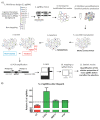CRISPR Screens in Synthetic Lethality and Combinatorial Therapies for Cancer
- PMID: 33808217
- PMCID: PMC8037779
- DOI: 10.3390/cancers13071591
CRISPR Screens in Synthetic Lethality and Combinatorial Therapies for Cancer
Abstract
Cancer is a complex disease resulting from the accumulation of genetic dysfunctions. Tumor heterogeneity causes the molecular variety that divergently controls responses to chemotherapy, leading to the recurrent problem of cancer reappearance. For many decades, efforts have focused on identifying essential tumoral genes and cancer driver mutations. More recently, prompted by the clinical success of the synthetic lethality (SL)-based therapy of the PARP inhibitors in homologous recombinant deficient tumors, scientists have centered their novel research on SL interactions (SLI). The state of the art to find new genetic interactions are currently large-scale forward genetic CRISPR screens. CRISPR technology has rapidly evolved to be a common tool in the vast majority of laboratories, as tools to implement CRISPR screen protocols are available to all researchers. Taking advantage of SLI, combinatorial therapies have become the ultimate model to treat cancer with lower toxicity, and therefore better efficiency. This review explores the CRISPR screen methodology, integrates the up-to-date published findings on CRISPR screens in the cancer field and proposes future directions to uncover cancer regulation and individual responses to chemotherapy.
Keywords: CRISPR screen; cancer therapeutic resistance; combinatorial therapy; synthetic lethality.
Conflict of interest statement
The authors declare no conflict of interest.
Figures


References
Publication types
Grants and funding
- FANCOSTEM and FANCOLEN/ICREA-Academia programme, Spanish Ministry of Health
- projects CB06/07/0023 MCI, UE and RTI2018-098419-B-I00 MCI, UE/Spanish Ministry of Science, Innovation and Universities
- EUROFANCOLEN project HEALTH-F5-2012-305421/European Commission
- FEDER/Fanconi Anemia Research Fund Inc and the 'Fondo Europeo de Desarrollo Regional, una manera de hacer Europa'
LinkOut - more resources
Full Text Sources
Other Literature Sources

